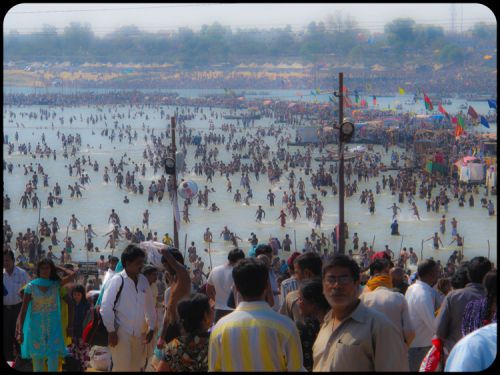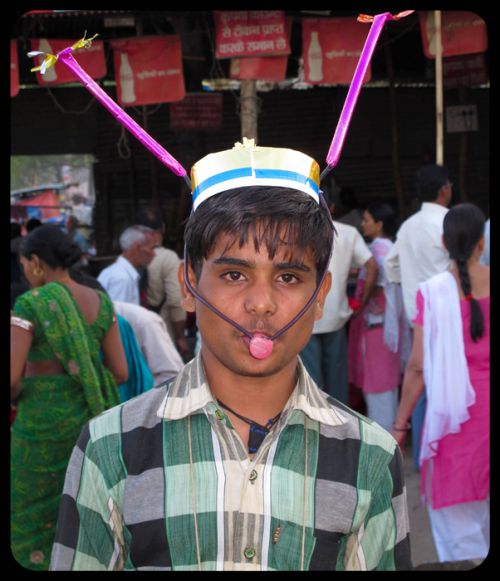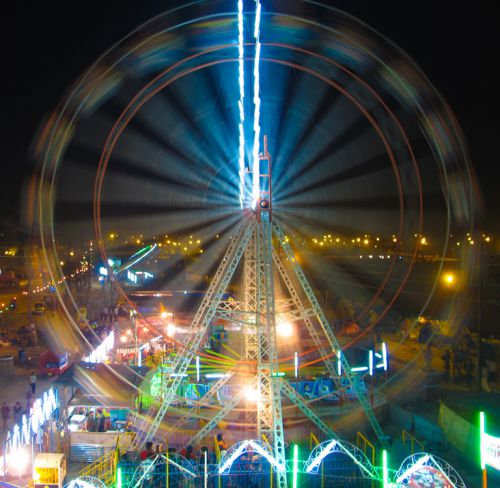13 De Shiv'Allahabad à Varana'Shiva 12/03/2013
Agora baba, Shiva Ratri, Sangam, Allahabad
Tous les 3 ans se déroule en Inde la fameuse Kumbha mela, un des plus gros pèlerinages au monde rassemblant quelques millions d’indiens (surtout) en un lieu précis qui change tous les 3 ans : Haridwar (Uttaranchal), Ujjain (Madhya Pradesh), Nasik (Maharashtra) et la plus importante celle d’Allahabad (Uttar Pradesh). Cette année elle y avait lieu du 27 janvier au 25 février mais a continué officieusement jusqu’à la Shiva Ratri, le 10 mars. Toujours esclave des contretemps, je ne pouvais me rendre à Allahabad durant la période officielle mais m’y rendis pour la Shiva Ratri. Du monde il y en restait et il en vint encore, par flots constants et réguliers, les mêmes qu’ailleurs en Inde, tels les sectateurs hypnotisés, sous influence d’une croyance puissante qui gère leur vie et leur « temps libre ». Du monde il y en avait sans doute moins que lors des bains sacrés de février, mais il y en avait tout de même jusqu’au bout de l’horizon, aussi loin que notre regard puisse porter, aussi proche que notre espace vitale puisse le tolérer. Du monde il y en avait tant que l’idée de l’individu, être autonome et unique, paraissait être une idée tirée d’un roman de fiction. Cette masse d’humains ne me semblait être qu’une entité unique, constituée d’atomes à cagoule, d’atomes hagards, d’atomes calmes ou excités mais globalement dans les rangs. Un objectif : rejoindre le Sangam, endroit où se rejoignent trois rivières sacrées : la Yamuna, le Gange et la mythique Saraswati, pour s’y baigner et croire encore aux bienfaits du bain sacré. On marche, on mange, on dort, on marche, on mange, on dort, on marche jusqu’au Sangam pour s’y baigner puis on marche, on mange, on dort et on marche de même au retour qu’à l’aller.
Le bain de la Shiva Ratri s’effectuait le matin du 10 mars, la fête continuait le soir à Varanasi, alors la route m’y emmena.
Le bain sacré est pris, on peut rentrer // The holy bath is taken, we can go back home
Au matin du dernier jour de la Kumbh mela d'Allahabad 2013, et jour de la Shiva ratri, les pèlerins se ruent en flots continus dans les eaux de la rivière sacrée.
In the morning the very last day of the Allahabad Kumbha mela 2013, and for the day of the Shiva Ratri, the pilgrims rush towards the water of the holy river.
Aussi loin que l'horizon // As far as the horizon
Matin de la Shiva Ratri, Sangam, Allahabad // Morning of the Shiva Ratri, Sangam, Allahabad
La grande migration de la Shiva Ratri // The big migration of the Shiva Ratri
ça va bloquer aux toilettes :/ :) // It's gonna be busy in the toilettes :/ :)
Rien de mieux qu'une bonne glace en cette chaude journée. Faut juste trouver la bouche.
Nothing better than an ice-cream during these hot days. Just have to find the mouth.
J'ai aussi rencontré un vieux Rajasthanais qui a dit à l'âge de 2 ans : "scout toujours".
I also met an old rajasthani man who claimed at the age of 2 : "Once a scout, always a scout".
Agora baba, Shiva Ratri, Sangam, Allahabad
La fatigue, la chaleur, les privations, l'extrême promiscuité n'entament pas la bonne humeur du pèlerin et des gosses du coin.
The tiredness, the heat, the privations, the promiscuity don't stop the pilgrims' good mood, neither the local kids'mood.
Poster représentant l'endroit et sa mythologie // Poster showing the place and its mythology
Paysanne de l'Uttar Pradesh et son beau tatouage de Krishna & Radha.
Farmer from Uttar Pradesh with her beautiful tattoo, Krishna & Radha.
Tatouage ornemental d'une fermière de l'Uttar Pradesh
Ornemental tattoo on a farmer lady from Uttar Pradesh
Et voilà, la fête se continu à Varanasi, alors : en bus pour une grande leçon de patience ;)
The party goes on in Varanasi : a bus trip for a great lesson of patience ;)
Sept heures de bus pour couvrir les 130 kilomètres de Allahabad à Varanasi. Cool ! on est parti à 16 heures pour arriver à Varanasi à 23 heures. Sympa d’arriver à Bénares sans vraiment savoir où aller sauf le nom d’une guesthouse mal indiquée et se situant dans le dédale de rues allant en amont du Dasaswamedh ghat. Je rêvais juste d’un accueil sans chiens : moutons de jour et loups du soir. Quel long voyage en bus, à croire que le chauffeur n’avait rien à faire de sa soirée et s’est dit qu’il pourrait la partager avec nous. On allait si vite que j’aurai pu cueillir des fleurs au passage, si il y en avait eu. La chose comique c’est que de rester à l’arrêt influençait peu notre moyenne de temps nécessaire à rallier les deux villes, et je rajouterai : heureusement qu’une grosse partie du chemin se fait en autoroute. Le problème a aussi consisté au fait que lors de la traversée de certains villages, la police essayait de régler la circulation : ça n’aide pas, rien de pire !! Bon c’est comme ça, j’aurai du me faire aussi indien qu’un indien averti et j’aurai consulté un astrologue avant de décider de mon départ.
Puis dans Bénares, même à pied dans les ruelles, ça n’avançait pas, y’avait-t-il un policier dans le coin ?
Mais j’étais enfin à Varanasi, je la retrouvais telle qu’elle m’avait laissé voici quinze ans, puis voici huit ans : épuisé et fasciné. Toutes ces années et la fascination du lieu s’y produisait toujours, au bord du Gange ou dans ses ruelles étroites.
Arriver dans Bénares un soir de Shiva Ratri ne paraît pas être du tout judicieux, surtout en cette année exceptionnelle en terme d’affluence (suivant les dires des locaux). Il me semblait que toute l’Inde qui ne s’était pas déplacée à Allahabad s’était réunie ici. Bientôt il faudra construire un étage à la rue, sinon deux. Le soir de cette Shiva Ratri la rue accepte et héberge une foule inconcevable, puis la musique, les cris, le mouvement des foules, la ferveur sous les étoiles, tout y était pour célébrer le miracle de la vie.
Toutes les guesthouses des environs étaient complètes, à craquer de pèlerins indiens et népalais. Le sud surtout avait fait le chemin, il s’était concentré ici, sur les bords du Gange. Beaucoup avait fait ce long trajet (de nombreux pèlerins d’Andhra Pradesh et du Tamil Nadu) pour célébrer comme il se doit le décès d’un proche, et aussi pour se faire plumer par les brahmanes de Bénares officiant à ce genre de cérémonie au bord du Gange. On pouvait voir de nombreuses personnes, hommes, femmes et enfants, le crâne rasé, certains hommes ayant conservé une touffe de cheveux à l’arrière du crâne, coutume attachée à la mort d’un parent. Le coiffeur c’est pour la permanence (et la permanente :). L’impermanence s’en passe … de ce que j’en sais !
Sur les ghats, toujours la même foire, le même cinéma en plein air : saddhus vrais et faux, mendiants (ne pas mélanger les deux, même si parfois, souvent ...), chèvres habillées de vieux t.shirts, vendeurs ambulants, paumés de la planète, touristes hébétés ou jouant les habitués de l’endroit « Home Sweet Home », et les indiens de l’endroit qui se font souvent voler la place. A Bénares les locaux se prendraient vite pour un escargot qui se ferait squatter : à l’étroit, plus chez soi.
Le train subit aussi l’impermanence mais sanctionne les retards : j’avais dix minutes de retard, et au lieu des dix heures de train, allongé à y passer ma nuit, j’écopais de vingt-sept heures de bus, assis, pour retrouver le chaos de Pahar ganj, Delhi, à l’identique de l’état où je l’avais laissé quelques jours auparavant (sauf quelques-uns qui avaient bougé).
Vieille pancarte dans le vieux Bénares // Old sign board in the old Benares
Les noms de cette ville : Bénares, Varanasi ou Kashi, à votre convenance.
This city names : Benares, Varanasi or Kashi, as you wish.
Ces jours-ci Shiva écoute les doléances et se fait prendre en photo avec les pèlerins.
These days Shiva listen to the grievances and pose for the picture with pilgrims.
Les cultes ancestraux demeurent à Bénares comme nulle part ailleurs. Aum Nama Shivaya !
The ancestral cults stay alive in Varanasi like nowhere else. Aum Nama Shivaya !
La grande Kumbh mela d'Allahabad a provoqué un flot inhabituel de pèlerins pour la Shiva Ratri de Bénares. Y'a de la vache et du pèlerin dans les ruelles sinueuses de la vieille ville.
The main Kumbha mela in Allahabad provocated a huge flood of pilgrims for the Shiva Ratri in Benares. There are cows and pilgrims in all the narrow streets along the ghats.
Every 3 years in India take place the famous Kumbha mela, one of, if not THE biggest pilgrimage in the world where gathers millions of indians (mainly) in a precise place that changes every 3 years. : Haridwar (Uttaranchal), Ujjain (Madhya Pradesh), Nasik (Maharashtra) and the most important, the Allahabad (Uttar Pradesh) one. This year it took place in Allahabad from the 27th of January until the 25th of February but it kept going unofficially until the Shiva Ratri, on the 10th of March. Always slave of setbacks, I could not make it to Allahabad during the official time but managed to be there for the Shiva Ratri. The crowd was still there, and more came over the top, by constant waves, the same ones than elsewhere in India, such as hypnotised sectarians under the influence of a powerful belief that manages their life and « free time ». The crowd was still there, surely less than during the holy baths in February, but the crowd was still in my sight, as far as the horizon would reach, as close as our vital space could take it. The crowd was so huge that the idea of individuality, autonomous and unique, semt to be a idea taken from a fiction novel. This mass of humans looked to me like being a unique entity, made of atoms with or without hats, of atoms with a crazed look in their eyes, a crowd made of calm or restless atoms still staying in line. One goal : to join the Sangam, place where meet the Yamuna river, the Ganga river and the mythic Saraswati, and have a dip in the water to believe still in the benefit of the holy bath. People walks, people eats, people sleeps, people walks, people eats, people sleeps, and they walk again until they reach the Sangam for this holy bath. Then people walks, people eats, people sleeps, and people walks the way back as they did the way up.
The holy bath of the Shiva Ratri occured in the morning, the 10th of March, and the party went on and on at night in Varanasi, so the road led me there.
Les eaux du Sangam, endroit où se rencontre le Gange et la Yamuna et la mythique Saraswati, n'est plus qu'à quelques centaines de mètres pour ces pèlerins qui en ont déjà mangé des milliers.
The waters of the Sangam, place where gathers the holy rivers Ganga, Yamuna and the mythic Saraswati, is just a few hundreds meters away.
La galerie commerciale de la Kumbh mela est très vaste et certains commerçants font à clin d'oeil à Shiva pour mieux vendre leurs produits.
The shopping area of the Kumbha mela is vast. Some shopkeepers try to get the favor of Shiva, anyhow. The painting with adoration of the lingam is a way.
Vishnou est aussi venu vendre // Vishnu also came to sale
A vrai dire, le "blanc", l'"occidental", le "westerner" est largement minoritaire.
To tell the truth, the "white", the "westerner" is rare around here.
C'est la fête, c'est la folie §>°¨ç>.*ù // It's party time, it's madness §>°¨ç>.*ù
La nuit de la Shiva Ratri, Khumbh mela 2013, la prochaine c'est dans 12 ans et si l'on regarde encore plus précisément dans les astres et les planètes, la prochaine identique astralement, c'est dans 144 ans. Mais là, je ne serai plus de cette planète pour sortir mon compas.
The night of the Shiva Ratri, Kumbha mela 2013, the next one is in 12 years, and if we even look closer in the sky and the planets, the same identical oneastrologically, it is in 144 years. But then I won't be there to enjoy it.
Le DJ mobile et Kareena Kapoor // The itinerant DJ and Kareena Kapoor
Shiva Ratri, Sangam, Allahabad, 10 / 03 / 2013
Pas moyen d'être tranquille. N'oubliez pas de fermer la porte !
No way to find peace :) Please shut the door !
Le serpent, le naga, un classique de l'hindouisme lié au culte de Shiva.
The snake, the naga, a classical of hinduism linked with the cult of Shiva.
Une femme tatouée d'un splendide motif tribal. Elle a bien voulu poser mais n'a pas voulu parler. J'ai pas dû tout comprendre., surtout avec tout ce qu'elle n'a pas dit.
A woman tattooed, decorated with a splendid design. She would accept to pose but would not speak. I guess that I did not understand everything, especially with all what she did not speak.
La fête foraine est aussi présente // The fun fair is there too
Seven hours to cover the 130 kilometeres that separates Allahabad and Varanasi. Cool ! We left Allahabad at 4 PM to reach Varanasi at 11 PM. Very nice to land in the city at night without knowing where to sleep, just in pocket the address of a non well-indicated guesthouse lost in the maze of the narrow streets, upstream from Dasaswamedh ghat. I was dreaming of a welcome without dogs : sheeps in daytime and wolves at night. What a long journey it was in that bus, I would believe that the driver invited himself in our lives and wanted to share that beautiful day, fully with us. The bus was going so slow that I could have picked up flowers while passing, if ever I would have seen some. The funny thing is that stopping did not seem to influence much the average speed, and I would add : fortunately that a long part of these 130 kilometers are « highways ». The problem partly came from the fact that crossing some cities, the police was ruling the trafic : it doesn’t help, just the opposite, nothing worse !! OK that’s the way it is, but I should have been more indian than indians, and I should have consulted an astrologist before moving.
Now in the streets of Benares, even walking in the narrow streets, it is blocked, is there any policeman trying to rule the trafic ?
But I finally reached Varanasi, I met it again as it left me fifteen and eight years back : exhausted and fascinated. All these years and the fascination remains, along the Ganga river or in its narrow streets.
Reaching Benares the night of the Shiva Ratri does not seem very judicious, especially for this year, an exceptionnal one in term of crowd (following the locals’ point of view). It looked to me that all the indians who did not make it to Allahabad were here in the city of Shiva. Soon they authority of the place will have to build a first floor to the streets, if not a second too ! The night of this yearly holy day the street welcomes and shelters a huge crowd : the music, the shoutings, the movement of humans, shallow and energetic, the devotion under the stars, everything was there to celebrate the miracle of life.
Every guesthouses of the surroundings were full, full of indian and nepalese pilgrims. Especially the South was in number. They made this long way North, mainly from Andhra Pradesh and Tamil Nadu, to honour as it should be done, the death of a family member, and to get fleeced by the Varanasi brahmanes who run such ceremonies by the Ganga. Many bold people, the skull freshly shaven, men, women, children. Some kept a clump of hair on the back of the head, custom attached to the death of a parent. The hairdresser is for the permanence. The impermanence can get rid of it … as far as I know !
Along the ghats, still the same show, the same open-air cinema : saddhus, real and fakes, beggars (don’t mix both !!), goats dressed with old t.shirts, street sellers, lost souls from the whole planet, stupefied tourists or acting cool as they were in the birth city « Home Sweet Home », and the locals who get their city hijacked. In Benares, the locals would quickly feel like a snail who would get squatted : in the narrow, not feeling home.
The train is also subject to the permanence but punishes the delays : I have been ten minutes late, and instead of ten hours of train, lying on my berth over the night, I got another special offer : twenty-seven hours bus trip, sit, to reach the chaos of Pahar ganj, Delhi, same as I left the place a few days before (only a few ones moved ).
Bénares, sur les ghats // Benares, on the ghats
Un brahmane du sud, tatoué de Shiva et au crâne creusé de sillons.
A southern brahmane, tattooed of a Shiva design and with the skull full of furrows.
Peinture de Shiva sur les murs des ghats // Painting of Shiva on the walls of the ghats
Peinture sur un mur de la vieille ville // Painting on a wall in the old city
PREVIOUS : 12 Erik, tattoo'wallah, Delhi
A découvrir aussi
- 12 Erik, Tattoo'wallah à Delhi 05/03/2013
- 15 Interview Bharat Suneja 25/03/2013
- 18 Rajesh Kumar Pal, tattooist in Manikaran
Inscrivez-vous au blog
Soyez prévenu par email des prochaines mises à jour
Rejoignez les 89 autres membres





































